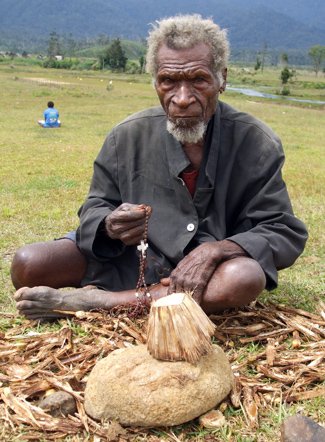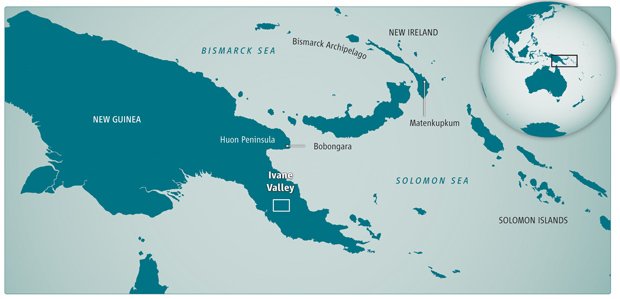PNG find prompts human migration rethink

ANCIENT ARTEFACTS UNEARTHED IN the highlands of Papua New Guinea provide some of the earliest evidence of human settlement of Sahul, the primordial landmass that once joined Papua New Guinea with Australia.
Charred nut shells from pandanus trees, fragments of animal bone and the remains of stone axes were found in the remote Ivane Valley of south-eastern Papua New Guinea – near the famous Kokoda Track – by a team led by archaeology Professor Glenn Summerhayes from the University of Otago, New Zealand.
These artefacts, which have been dated to between 49,000 and 44,000 years old, may prompt a rethink of the traditional view that the prehistoric migration of people throughout the world took place along the coasts.
“This is among the earliest evidence of human habitation in this part of the world, or indeed any place outside Africa, India and the Middle East,” Glenn told Australian Geographic. “Many models for the movements of people argue for a colonisation route along the coast, arguing that people were pre-adapted to a coastal way of life…Our evidence shows such a pre-adaptation would have been short lived as people moved into highland valleys as soon as they got out of their canoes.”

Ivane Valley resident, Paul Lamui, demonstrates how to use rocks to crack pandanus nuts open – the same method used 49,000 years ago according to excavation evidence in the Ivane Valley of PNG. (Photo: Andrew Fairbairn)
“Cold, uncompromising place”
The team’s study is published today in the journal Science.
Professor Peter Bellwood, an archaeologist at ANU who was not part of the team, agrees the wealth of evidence found in the Ivane Valley “provides the first reliable dates for the earliest habitation of the PNG Highlands.”
Professor Chris Gosden from the University of Oxford – who writes a related article in the same issue of Science – says its unlikely early humans would have lived there permanently as it was a “cold, difficult and uncompromising place to live at any time over the past 50,000 years.”
Starch grains from yams recovered in the valley appear to support this, having most likely been transported there from their natural habitat in the lower elevations closer to the country’s steamy sub-tropical coast.
Highly mobile
Archaeologist Dr Andrew Fairbairn from the University of Queensland, who worked with Glenn on the research, says this suggests early humans lived in small nomadic populations that moved up and down the mountains of Papua New Guinea in search of food.
“They clearly were very mobile. We assume [they lived in] some form of egalitarian structure, but it’s very difficult to say from the archaeological remains alone. It was a very cold period in history and these people were both resourceful and capable to be able to live at this altitude,” he says.
Long isolated by water, Sahul is thought to have been colonised via canoe from Southeast Asia sometime after 50,000 years ago. While the Papua New Guinea Highlands was one of the areas first settled by the new arrivals, evidence exists of the presence of these early humans – who are also believed to be the ancestors of the modern Aboriginies – in Australia from around the same time.
While DNA evidence proves this common ancestral link between Australia’s Aboriginies and their modern Melanesian cousins, rising sea levels around 8000 years ago seperated the two groups of people, leading to significant subsequent differences.
A map of the Ivane Valley in Papua New Guinea (Photo: AAAS)
MORE INO
PNG: Our sultry neighbour
Tiny new kangaroo: “spectacular find”




